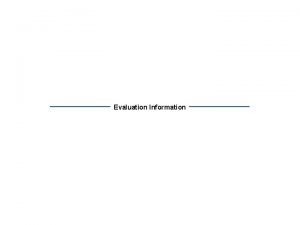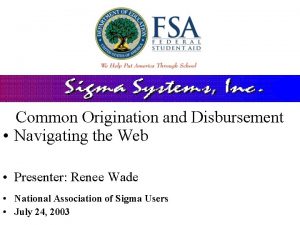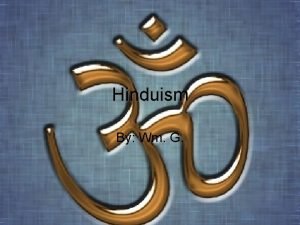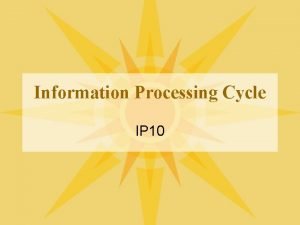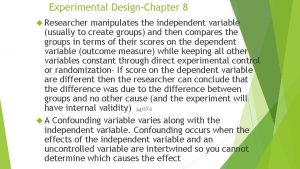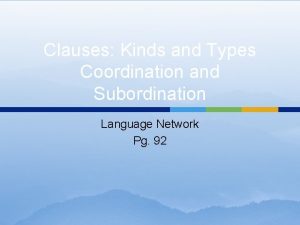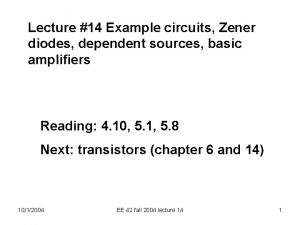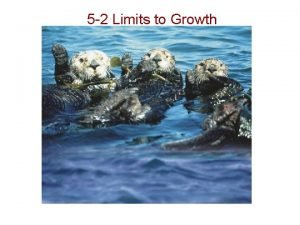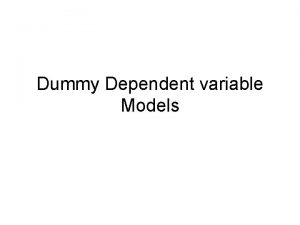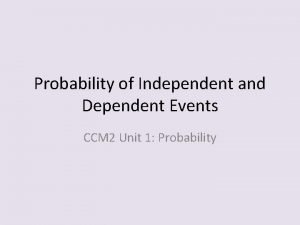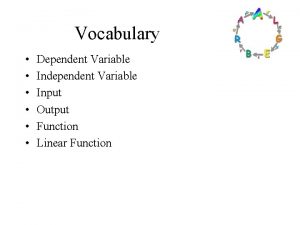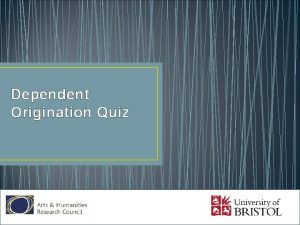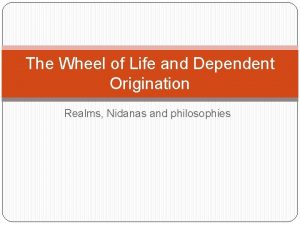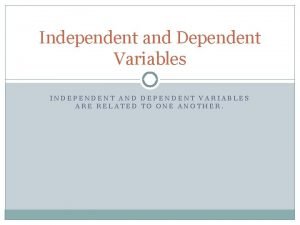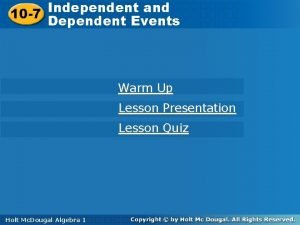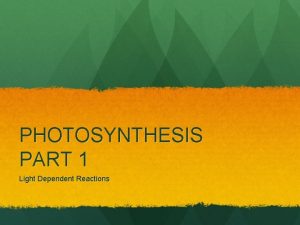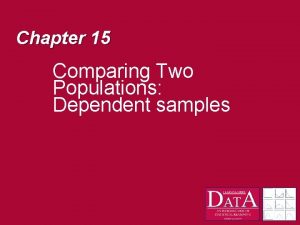Dependent Origination What is Dependent Origination Dependent Origination



















- Slides: 19

Dependent Origination

What is Dependent Origination? • Dependent Origination (pratītyasamutpadā/ paṭiccasmuppāda) is the Buddhist doctrine of causality. • This system of thought maintains that everything has been caused into existence. Nothing has been created ex nihilo. • This is useful in understanding how there can be rebirth without a belief in a soul. When a person is alive they generate karma, this does not simply disappear at death. Instead, due to the remaining karmic seeds a new being is caused into existence so that remaining karmic results may take place. • In relation to rebirth, the Buddha taught a twelvefold formula for Dependent Origination in many suttas such as the Mahānidāna Sutta (which can be viewed here)

Some things to Remember… • Dependent Origination is linked to other Buddhist ideas such as the Middle Way, saṃsāra and karma. • Before looking at Dependent Origination in depth it is worth having a quick look at saṃsāra and karma as it will make it easier to understand.

Saṃsāra • Saṃsāra is not a place, instead it is the type of existence experienced by all unenlightened beings. • Unenlightened beings are caught in perpetual cycle of life, death and rebirth. • Saṃsāric existence is conditioned by three marks: impermanence (anitya/ anicca), not-Self (anātman/ anattā), and dis-ease (duḥkha/dukkha).

Saṃsāra • As there is no permanence there is no stability. Saṃsāric existence is in a constant state of flux and change. • The teaching of anātman outlines that there is nothing that has a permanent Self, there is no underlying consciousness or sense of person that is carried from life to life. • There is no being that can be classed as immortal, even the gods (devas) that are found in Buddhist thought will one day die.

Within saṃsāra there is nothing that is immortal. Everything is impermanent. This photo is of a coffin being prepared for a funeral in Laos (2007). Beings will have many lives and deaths.

Karma • Karma or kamma can be translated as ‘action’. • In the brahmanical society it was initially understood in terms of ritual action. If one performed a certain ritual action correctly, it would have a specific desired result. If the conditions were not right, no result would occur. • Ideas concerning karma evolved and in the Upanishads we find the beginnings of an ethicisation of karma. All intentional actions (good or bad) were understood to cause an effect (good or bad). Actions performed by an individual would cause some sort of effect on the individual in this life, or even in a later life.

Karma • In Buddhist thought karma has a causative nature. The actions that are intentionally performed by the individual will have a particular karmic result. Well-intentioned good deeds will result in a pleasant and favourable karmic result whilst malicious and hurtful misdeeds will result in a poor and unfavourable karmic result. • Karma does not always have immediate results, but can take many lifetimes to have an effect.

Listening to a dharma talk, like these lay people in Myanmar (2009), can help generate good karma.

What is causality? • Dependent Origination is a system of causality. • This means that within saṃsāra everything exists because of a prior cause. • An example of this would be the link between milk and curd. Milk, due to a certain cause, is turned into curds. Milk and curd are not the same, but they have a causal link. • Saṃsāra is a ceaseless series of cause and effect. Although there might be the appearance of stability this is not the case.

What does that imply? • As everything has been caused to some condition it means that there is nothing eternal. Likewise it shows that things do have an existence meaning that Buddhist doctrine is not nihilistic. It is evidence that Buddhism is the Middle Way between two extremes. • It also points the way towards the cessation of saṃsāra. New existents only arise if there is a cause. If there are no causes then nothing will arise. • It also provides an explanation as to why there can be rebirth without a permanent self, an ātman.

The Buddha, through his enlightenment, stopped generating the kind of karma that would lead to another rebirth. (Hong Kong, 2011).

Dependent Origination and Rebirth • When a person dies the reborn being is not the same as the deceased but at the same time is not completely different. • The two beings (A and B) are linked through a causal process. The now deceased A had performed karmic actions and these past actions are factors in the cause that created B. • As A and B are connected by a shared karmic causality they cannot be completely different from each other. • There is a twelvefold formula for Dependent Origination which explains rebirth.

Offerings of food left for the dead in Laos (2007). By giving food and generating merit the families of the dead hope to improve the next life of their deceased relative.

The Twelvefold Formula of Dependent Origination • “conditioned by ignorance are formations, conditioned by formations is consciousness, conditioned by consciousness is mind-and-body, conditioned by mind-and-body are the six senses, conditioned by the six-senses is sense contact, conditioned by sense contact is feeling, conditioned by feeling is craving , conditioned by craving is attachment, conditioned by attachment is becoming, conditioned by becoming is birth, conditioned by birth is old age and death” Saṃyutta Nikāya II 2 Translation from Rupert Gethin, Foundations of Buddhism (Oxford: Oxford University Press, 1998), pp 141 -142 (full text of Paticcasamuppadavibhanga Sutta can be found here)

Twelvefold Formula continued… • The twelvefold formula of dependent origination appears to be in chronological order, but is actually seen as taking place over three lifetimes. • The first two links represent a past life. The actions of a previous life set in motion the causation of a new life. • The next eight links represent the present life. It starts with the arising of a new being in the mother’s womb, the physical body and mind. Then there are sense experiences and the resultant sensations of pain and pleasure. This leads to craving and clinging which lead to the creation of habits. • The last two links represent a future life. The acts of the present life time mean that there will be future births and deaths. • Edward Conze argues that the formula was originally used to show basic mental functions. This can be seen the Abhidharmakośa which is a treatise on the Abhidharma by Vasubandhu. They do not follow a chronological order but instead they occur simultaneously.

Twelvefold Formula continued Twelvefold Formula 3 Lifetimes Scheme Mental Process Scheme Ignorance First Life Ignorance Formations First Life Volition Consciousness Second Life Discriminating Consciousness Mind and Body Second Life The four skandhas co-existing with consciousness Six Senses Second Life Activity of sense organs Sense Contact Second Life Contacts involved in their activity Feeling Second Life Experience of the contact Craving Second Life Greed Grasping Second Life Obsessions associated with greed Becoming Second Life The physical and vocal acts that proceed Birth Third Life The production of all of the above dhammas Death and Old Age Third Life The maturity and breaking up of the dhammas Please see Edward Conze, Buddhist Thought in India (London: George Allen and Unwin Ltd. , 1962), p 157.

Summary • The teaching of Dependent Origination shows that saṃsāric existence is governed by a system of causality. Everything is caused into being and in turn causes more existents to arise. • The Buddha’s teaching of Dependent Origination also highlights that there is a way to stop further arising from occurring. This is done by reversing the causes of arising. One must not be guided by ignorance, but instead cultivate wisdom. One must not cling and crave, they should be aware of impermanence and act accordingly. • Understanding Dependent Origination is to understand the true reality, how things really are.

And Finally… • This is perhaps most succinctly put in the following verse: ‘this existing, that exists; this arises, that arises; this not existing, that does not exist; this ceasing , that ceases’. Majjhima Nikāya iii 63. Translation from Rupert Gethin, Foundations of Buddhism (Oxford: Oxford University Press, 1998), p 141.
 Loan origination best practices
Loan origination best practices Acaps loan origination system
Acaps loan origination system Common origination and disbursement
Common origination and disbursement Rerpl
Rerpl Local origination programming
Local origination programming Hinduism
Hinduism Information process cycle
Information process cycle Between groups design
Between groups design Kinds of subordinate clause
Kinds of subordinate clause System dependent recovery equipment cannot be used when
System dependent recovery equipment cannot be used when Zener diode
Zener diode Operationalizing dependent variables
Operationalizing dependent variables Positioning of patients in nursing
Positioning of patients in nursing Dependent edema
Dependent edema When do density dependent factors operate most strongly
When do density dependent factors operate most strongly Dummy dependent variable
Dummy dependent variable Identify independent and dependent events
Identify independent and dependent events What is continuous data
What is continuous data Output
Output A dependent clause is also called a
A dependent clause is also called a

